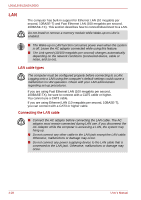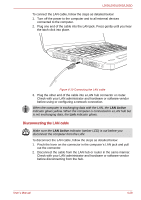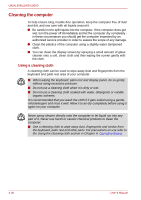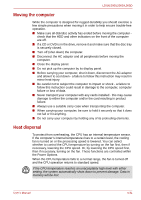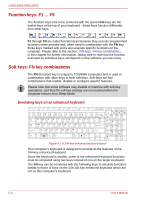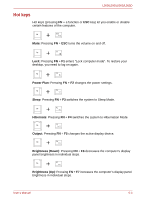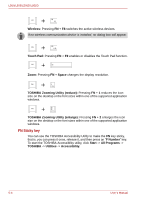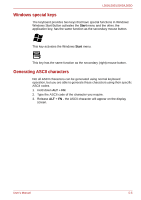Toshiba PSLV6U-00J001 User Manual - Page 95
The Keyboard, Typewriter keys, The Keyboard
 |
View all Toshiba PSLV6U-00J001 manuals
Add to My Manuals
Save this manual to your list of manuals |
Page 95 highlights
L500/L505/L500D/L505D Chapter 5 The Keyboard The computer's keyboard layouts are compatible with a 104/105-key enhanced keyboard - by pressing some keys in combination, all of the 104/105-key enhanced keyboard functions can be performed on the computer. The number of keys available on your keyboard will depend on which country/region your computer is configured for, with keyboards being available for numerous languages. In use there are six different types of keys, specifically typewriter keys, function keys, soft keys, Hot keys and Windows special keys. Typewriter keys The typewriter keys produce the upper-case and lower-case letters, numbers, punctuation marks, and special symbols that appear on the screen. However, there are some differences between using a typewriter and using a computer keyboard: ■ Letters and numbers produced in computer text vary in width. Spaces, which are created by a "space character" may also vary depending on line justification and other factors. ■ The lowercase l (el) and the number 1 (one), together with the uppercase O (oh) and the 0 (zero), are not interchangeable on computers as they are on a typewriter. ■ The CAPS LOCK function key locks only the alphabetic characters into upper-case while the Shift Lock function on a typewriter places all keys in the shifted position. ■ The SHIFT keys, the Tab key, and the BACK SPACE key perform the same function as their typewriter counterparts but also have special computer functions. Never remove the key caps on your keyboard. Doing so could cause damage to the parts under the key caps. User's Manual 5-1



